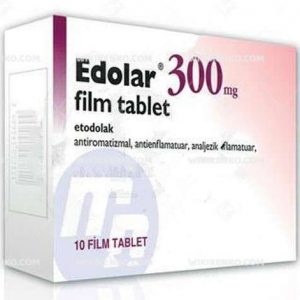
Ebafit Film Tablet 20 Mg
In the world of pharmaceuticals, Ebafit emerges as a significant contender. This comprehensive guide unveils the key aspects, delving into its composition, indications, precautions, administration, potential side effects, interactions with other medications, and its safety profile during pregnancy and breastfeeding.
| Dosage form | |
|---|---|
| Pack size | |
| Potency | 20 Mg |
| Manufacturer | |
| Origin | |
| Generic Name (Ingredient) | Ebastin 20, 00 Mg |
Assuming your emergency circumstances for this product, visit Urgent Quotation page. Besides, for any pharmaceutical questions, please ask us in the comments section.
Description
Active Ingredient: Ebastine
Ebafit is a pharmaceutical marvel, encapsulating 20 mg of the active ingredient, Ebastine, within its film tablet form. Ebastine is a second-generation H1 receptor antagonist, primarily indicated for allergic rhinitis and chronic idiopathic urticaria. This potent antihistamine is renowned for its efficacy in alleviating allergy symptoms.
Composition: The Building Blocks
In addition to Ebastine, Ebafit consists of several excipients, including microcrystalline cellulose (Avicel pH 102), pregelatinized starch, croscarmellose sodium, colloidal silicon dioxide, magnesium stearate, and opadry II White 85G18490 (polyvinyl alcohol, titanium dioxide (E171), talc, lecithin (soya(E322)), macrogol). These components work in harmony to create a reliable pharmaceutical solution.
Indications
Ebafit shines as a versatile pharmaceutical option, providing relief from a spectrum of allergy symptoms. In patients over the age of 12, it is employed in the treatment of:
- Allergic Conjunctivitis: Addressing itchy and watery eyes.
- Chronic Allergic Rhinitis: Offering solace for year-round allergic rhinitis.
- Seasonal Allergic Rhinitis: Providing respite from hay fever.
- Idiopathic Chronic Urticaria: Alleviating the discomfort of chronic hives with unknown causes.
- Allergic Dermatitis: Easing the burden of allergic eczema.
Contraindications
Ebafit should not be used by individuals who are allergic to Ebastine or any of its excipients. This precaution ensures the safety of those engaging with this pharmaceutical solution.
Precautions
The cautious use of Ebafit involves:
- Monitoring for abnormal electrocardiogram results, particularly prolonged QT intervals.
- Vigilance regarding high blood potassium levels.
- Consideration for individuals with severe liver disease.
- Awareness of potential interactions with azole antifungals, macrolide antibiotics, and rifampicin treatment for tuberculosis.
Administration: Flexibility in Usage
Ebafit offers convenience in administration, as it can be taken with or without food. This flexibility accommodates various patient preferences and needs.
Pregnancy/Breastfeeding
For individuals who are pregnant or breastfeeding, consulting with a healthcare provider or pharmacist before using Ebafit is essential. This ensures that the medication is employed with full awareness of any potential risks or benefits during these critical periods.
Side Effects
Like all medications, Ebafit may introduce side effects. Common occurrences include nausea, drowsiness, abdominal pain, dry mouth, headache, indigestion, insomnia, nosebleeds, nasal infections, sinus inflammation, sore throat, and weakness. Should any of these side effects persist or cause concern, promptly consulting a healthcare practitioner is recommended.
Interactions
Ebafit may interact with specific medications. Concurrent use with ketoconazole, itraconazole, clarithromycin, or erythromycin can elevate plasma levels of Ebafit and lead to QTc interval prolongation. Disclosing all medications to your healthcare provider before commencing treatment with it is crucial. This enables informed guidance on potential drug interactions and their management.
Conclusion
Ebafit stands as a pharmaceutical beacon, offering respite and relief to those grappling with allergy-related challenges. By exploring its composition, indications, precautions, administration, potential side effects, medication interactions, and its role during pregnancy and breastfeeding, individuals and healthcare providers can navigate the path to improved well-being with precision and care.
Use the form below to report an error
Please answer the questions as thoroughly and accurately as possible. Your answers will help us better understand what kind of mistakes happen, why and where they happen, and in the end the purpose is to build a better archive to guide researchers and professionals around the world.
The information on this page is not intended to be a substitute for professional medical advice, diagnosis, or treatment. always seek the advice for your physician or another qualified health provider with any questions you may have regarding a medical condition. Always remember to
- Ask your own doctor for medical advice.
- Names, brands, and dosage may differ between countries.
- When not feeling well, or experiencing side effects always contact your own doctor.
Cyberchondria
The truth is that when we’re sick, or worried about getting sick, the internet won’t help.
According to Wikipedia, cyberchondria is a mental disorder consisting in the desire to independently make a diagnosis based on the symptoms of diseases described on Internet sites.
Why you can't look for symptoms on the Internet
If diagnoses could be made simply from a textbook or an article on a website, we would all be doctors and treat ourselves. Nothing can replace the experience and knowledge of specially trained people. As in any field, in medicine there are unscrupulous specialists, differences of opinion, inaccurate diagnoses and incorrect test results.



Reviews
There are no reviews yet.